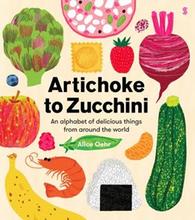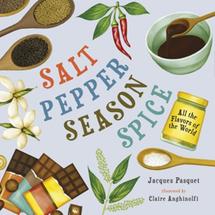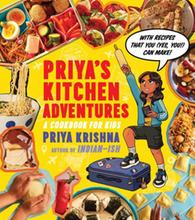We have titles to suggest for food-fascinated children and teens, whether they're still learning that "E" is for "egg" or already making ravioli from scratch.
 Artichoke to Zucchini: An Alphabet of Delicious things from Around the World by Alice Oehr (Scribble, $18.95, ages 3-7)
Artichoke to Zucchini: An Alphabet of Delicious things from Around the World by Alice Oehr (Scribble, $18.95, ages 3-7)
The happy discovery of "delicious things from around the world" paired with the reassuring predictability of an alphabet book makes Artichoke to Zucchini a terrific gift for emergent readers and future foodies. The book's large sturdy pages and rounded corners are just the thing for kids who are learning how to handle books with care. Bold featured letters are prominent in the corners, each introducing brief, often alliterative text: "F is for fluffy focaccia with herbs, and everyone's favorite--French fries." Brilliant colors shine from the spreads, with pencil, pastel, cut paper, and digital collage illustrations portraying a vast array of foods, some of which may not be familiar to every reader. Sure, B is for banana, but B is also for borlotti beans. W is for wombok and warrigal greens... as well as watermelon. And O is for orange, onion, onigiri, and oysters. Tantalizing details such as, "I is for... big wheels of injera bread (good for soaking up curries)" may inspire curious readers to investigate these tasty global treats further. Fans of Alice Oehr's previous title, Off to the Market, will likely eat up Artichoke to Zucchini as well. --Emilie Coulter
 Rebel Girls Cook: 100+ Kid-Tested Recipes You Can Make, Share, and Enjoy! by Rebel Girls Inc. (Ten Speed Press, $28.99, ages 7-up)
Rebel Girls Cook: 100+ Kid-Tested Recipes You Can Make, Share, and Enjoy! by Rebel Girls Inc. (Ten Speed Press, $28.99, ages 7-up)
Culinary Rebels share recipes and advice in a culturally inclusive, confidence-building cookbook that'll become a quick staple in young chefs' kitchens. More than 100 clear and concise recipes are organized by dining category: breakfast, lunch, snacks, dinner and sides, and desserts. Most fit on a single page and are accompanied by crisp, appealing photographs of ingredients or a finished product, which whets appetites and interest. Many recipes get the full Rebel Girls franchise treatment, with biographies and dynamic illustrations of their notable female chef-creators, while peppered throughout the book are informative visual pops like "Fun Food Facts" and snappy reviews from young testers. Vegan and vegetarian options are helpfully labeled with symbols, as are simple versus involved projects and potentially dangerous steps (heating oil in a skillet for Cháo Gà, for example, or reminding chefs to use mitts when removing Chocolate-Hazelnut Swirl Banana Bread from the oven). With simple dishes that cater to beginners (Avocado Toast) as well as more elaborate recipes with substitutions that encourage creative flair (Stovetop Flatbreads), this delectable and empowering cookbook will likely grow with its readers. --Kit Ballenger
 World Kitchen: A Children's Cookbook by Abigail Wheatley, illus. by Chaaya Prabhat (Usborne, $16.99, ages 7-up)
World Kitchen: A Children's Cookbook by Abigail Wheatley, illus. by Chaaya Prabhat (Usborne, $16.99, ages 7-up)
World Kitchen: A Children's Cookbook is a lively and colorful collection of recipes which are all submissions from families who live around the globe. The easy-to-follow instructions--such as those for Korean zucchini pancakes and Algerian kesra bread--allow families to explore a range of flavors in approachable, child friendly ways. A page of illustration announces each recipe and its ingredients and depicts family life within the culture from which the dish is taken. Every recipe begins with a note from the family who provided the recommendation and individual steps are shown in attractive, readable comics-style panels. Recipes include variations to replace unfamiliar ingredients or to avoid allergens, and there is a helpful section at the end of the book on "swapping ingredients." The cookbook also provides a QR code that leads to videos displaying cooking techniques and a "recipe map" that shows where all the families live. World Kitchen is a great addition for the family that not only wants to start teaching cooking skills, but wants to explore different cuisines together, with recipes vetted by the best critics possible: other families. --Michelle Anya Anjirbag
 Salt, Pepper, Season, Spice: All the Flavors of the World by Jacques Pasquet, illus. by Claire Anghinolfi, trans. by Ann Marie Boulanger (Orca Book Publishers, $24.95, ages 9-12)
Salt, Pepper, Season, Spice: All the Flavors of the World by Jacques Pasquet, illus. by Claire Anghinolfi, trans. by Ann Marie Boulanger (Orca Book Publishers, $24.95, ages 9-12)
History lands on the dinner plate in Salt, Pepper, Season, Spice: All the Flavors of the World by Jacques Pasquet, translated from the French by Ann Marie Boulanger and with art by Claire Anghinolfi. Right up front, Pasquet lays out his persuasive thesis statement with gusto: "Whenever our taste buds are tickled by a particular taste or smell, we're actually savoring a little corner of the world and its history." Each of 11 chapters is devoted to a single ingredient--salt, pepper, mustard, chocolate, and so on--and relays the ingredient's origin, varieties, uses, and more. The book's history goes down easy, spiked as it is with interesting tidbits, like "In the past, salt was rubbed on babies' lips to ward off evil spirits" and cinnamon "was used to disguise the unpleasant smell of food that had gone bad." Fun facts are sometimes augmented with funny faces: Anghinolfi's historically attuned, no-detail-spared illustrations, largely in savory earth tones, include portraits of kids reacting candidly to the oomph-y properties of featured ingredients ("Why does pepper burn?"). Young readers will definitely want to try this at home. --Nell Beram
 Priya's Kitchen Adventures: A Cookbook for Kids by Priya Krishna, illus. by Anu Chouhan, photography by Mackenzie Smith Kelley (Harvest, $29.99, ages 8-12)
Priya's Kitchen Adventures: A Cookbook for Kids by Priya Krishna, illus. by Anu Chouhan, photography by Mackenzie Smith Kelley (Harvest, $29.99, ages 8-12)
Future cooks will be able to travel around the world via their palates with Priya's Kitchen Adventures: A Cookbook for Kids. The New York Times food reporter and YouTube star Priya Krishna's cooking primer for young readers offers more than 50 recipes, all of which are anchored by her personal stories. Excerpts of real-life tales about countries Krishna visited with her family as a child are directly tied to featured dishes, like the Kiwicha porridge she had while camping in the Amazon rain forest in Peru or the crepes she watched Parisian street vendors make. This personal narration is further brought to life through old vacation photos and Anu Chouhan's manga-style illustrations. The "food diary" vibe of the introduction establishes the casual, upbeat tone Krishna uses when explaining an entrée's origin, preparation methods, and ingredient selection. Each recipe is also flagged in terms of difficulty level. Those indicated as "hard"--such as Dou Sha Bao and Pear and Gorgonzola Ravioli--are made more accessible by accompanying step-by-step photographs by Mackenzie Smith Kelley. Kids ready to cook with less adult supervision will do well with Krishna as their guide. --Rachel Werner

